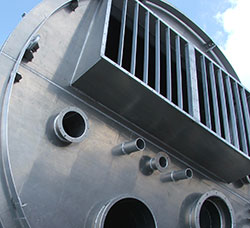ATEX
Barton silos are fully compliant with all ATEX requirements.
ATEX legislation has been widely covered by the media, and all silos used in the food industry must now be compliant to ATEX 137. Barton has been at the forefront of developments around ATEX rated pressure vessels and industrial silos.
For more information on ATEX compliance download the SHAPA Practical Guidance for Suppliers and Operators of Solids Handling Equipment for Potentially Explosive Dusts.
Continued relevance

Explosion panels and connections at the top of the silo
Since 1st July 2003 all manufacturers of products used in areas where potentially explosive atmospheres exist have had to supply equipment which complies to ATEX Directive 94/9/EC (ATEX 100). In addition, there is also legislation under Directive 99/92/EC (ATEX 137) which is aimed at the responsibilities of the end user.
All hazardous area workplaces, which were used for the first time after 30th June 2003, have had to comply with ATEX 137 however, workplaces in use before that date have been given a transitional period to achieve compliance which ended 30th June 2006.
Within ATEX 137, the employer must ensure that all reasonable steps are taken to avoid the formation of explosive mixtures. If they do exist then measures must be taken to avoid ignition. Finally, if ignition does occur, the effects of any explosion must be minimised in such a way that workers' safety is not put at risk.
ATEX 137 focuses on minimising the risk to workers by classifying the working environment into zones and then specifying the category of equipment that can be used in each zone. The dust hazard classification is as follows:-
Zone 20 - Permanent presence of combustible dust
Zone 21 - Incidental presence of combustible dust during normal duty
Zone 22 - Accidental presence of combustible dust, but not during normal duty
ATEX in the baking industry
Powders such as flour and sugar are routinely stored on site at bakeries. These fine powders, when mixed with air, form a potentially explosive mixture. Such conditions frequently occur within storage vessels during plant operation and as such are typically classified as Zones 20 / 21. In order to comply with the provisions in ATEX 137, bakeries must therefore ensure that the storage vessels comply with ATEX 100.
Compliant silos
To ensure silos are designed built and supplied to comply with the requirements of ATEX 100, the following must be considered:-
Explosion characteristics of the stored product
Silo design and explosion vent specifications
Vent area
Silo supply documentation
Individual powders and dusts have their own explosion characteristics. These include minimum ignition energy, ignition temperature, minimum explosible concentration, maximum oxygen level, maximum explosion pressure and maximum rate of pressure rise. This means that sugar and flour for example behave differently both in susceptibility to explode and pressure rise / maximum pressure if they do explode. These characteristics are fundamental to silo design calculations and explosion vent specification.
Put simply, the silo must be strong enough to contain any explosion without sidewall rupture. This is dependent upon having calibrated explosion vents with sufficient vent area to limit the internal pressure rise to a calculated maximum during any explosion. Not only should the silo supplier design and build the silo to meet the ATEX requirements, but documentation must accompany the product which outlines the silo design calculations, drawings, explosion vent calculations and silo certification.
How to comply
Each bakery must ensure that any storage vessel they have on site, where there is a risk of explosion, is built to ATEX standards and has the necessary documentation to prove it. Of particular note is that 'own design' vent membranes and doors are no longer acceptable unless certified by explosion testing in conjunction with a notified body.
Barton has extensive experience in providing ATEX compliant silos to the food industry and is able to provide full assistance in silo specification.
In addition to supplying new ATEX compliant silos, Barton can refurbish existing silos to ensure they are fully ATEX compliant.
Contact Barton to discuss your needs. A site survey can then be arranged and full quotation provided to bring your silo up to meet the current ATEX requirements.